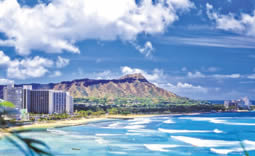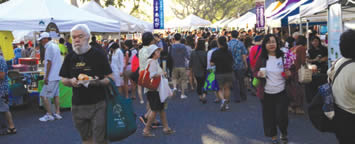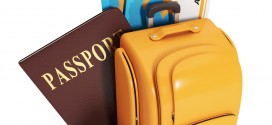By Daphne Domingo

 HONOLULU, HI—So what brought me from Washington’s winter bleakness to Hawaii’s gentle caress? That’s easy: the consistently warm weather, stunning scenery, rich culture and a variety of activities to match all kinds of interests, especially if you’re Asian American. Almost every opportunity is taken to boast a local celebration honoring Asian holidays, including a month-long celebration for Lunar New Year in Honolulu’s Chinatown that includes festivals, a pageant, a street fair and of course, a parade. Plus, with the abundance of Asian food everywhere, Hawaii is like Annandale. Only in paradise!
HONOLULU, HI—So what brought me from Washington’s winter bleakness to Hawaii’s gentle caress? That’s easy: the consistently warm weather, stunning scenery, rich culture and a variety of activities to match all kinds of interests, especially if you’re Asian American. Almost every opportunity is taken to boast a local celebration honoring Asian holidays, including a month-long celebration for Lunar New Year in Honolulu’s Chinatown that includes festivals, a pageant, a street fair and of course, a parade. Plus, with the abundance of Asian food everywhere, Hawaii is like Annandale. Only in paradise!
Almost 8 million visitors visited Hawaii in 2012, breaking the 7.6 million high from 2006, according to the Hawaii Tourism Authority. It may seem out of reach, given the long distance (a 9-hour direct flight from D.C.) and notoriously high prices caused by shipping costs from the mainland. Still, 1.7 million visitors from the East Coast thought the trek was worth it last year, so much so that direct flights out of DC and New York have increased 30.1%.
So, it takes some research to figure out the best deals. To help you start relaxing early, I have done some of it for you. Below are a few tips to help make your trip more budget-friendly.
Getting There
Some times are better than others — at least cost-wise. Avoid peak seasons like winter holidays (OK, I broke that rule!) and summer breaks when prices can skyrocket. April-June and September-November are considered off-season, but are still wonderful times to visit.
Two trips for less
Bundle and save. It takes creativity and flexibility to figure out where and how to get the best bang for your buck. It also takes a good travel agent or website like Travelocity, Expedia or Orbitz. These companies negotiate flights and accommodations directly with airlines and hotels, and then package them together. So if you don’t have or want to take the time to do all the research yourself, it’s an easy option.
Staying There
Check hotel websites regularly. Nancy Daniels, Director of Public Relations for Outrigger Hotels, recommends always checking online. Rates fluctuate, depending on occupancy and time of year, but the Outrigger website, for instance, always lists the best currently available prices.
Consider a house or condo. Websites like Wimdu and Airbnb help locals rent out rooms or their entire homes. You get more space, a kitchen, and possibly parking and washer/dryer. You also get the opportunity to live more like an Islander than a tourist, often for far less than you would pay at a hotel.
Take the location, but forego the view. Where a beachfront location really matters, premium properties offer dramatically less expensive views of city, garden or mountain vistas. You are still just steps away from the beach or commercial strip, and can still enjoy first class services and amenities.
Mind the fees and search for value. When looking at resorts, be on the lookout for fees not included in their listed rates. Daniels points out that their beach resorts do not charge “resort fees” while offering free wifi, complimentary US telephone calls, cultural activities and even free vow renewals for guests. Some hotels, like Embassy Suites (managed by Outrigger), offers a breakfast buffet, An evening reception, plus full suites with separate bedroom and kitchenette.
Eating There
Rent a room AND a kitchen. Consider a condo or a room with a kitchenette. There are farmers’ stands, fresh bakeries and local food stores everywhere in Hawaii. A great way to experience local culture is to shop for local foods, especially the succulent produce that grows in Hawaii year-round. Take advantage of the year-long growing season for fresh and ripe avocados, bananas, mangoes, pineapples, kale, taro, tomatoes, starfruit, onions, mushrooms and melons, just to name a few. It’s also a great opportunity to experience some only-in-Hawaii delicacies like banana blossoms (yes, they are deliciously edible) and winter watermelon, which is much heartier than our typical watermelons with yellow flesh instead of pink.
Start a day of exploration with breakfast in the room, then prepare lunch or snacks for the day. And if you decide to use the money you save by splurging on dinner, you can refrigerate and then heat up your leftovers.
Buy it outside. Poke (pronounced poh-keh), the cubed sashimi salad very popular in Hawaii, can cost around $18 for a few cubes at a hotel resort. But you can visit a nearby Safeway and the same $18 can buy you almost 2 pounds (half-pound is enough for two), and you can choose from a variety of styles and flavors. Buy the poke along with other treats, and take them to the beach for an authentic Hawaiian experience.
Buy local. Farmers markets are always a great option, both home and while traveling, and they’re a great way to experience local culture. In Hawaii, produce at markets tends to be cheaper than in grocery stores, too. Check opening and closing times, as they can open as early as 7:30, and locals tend to get there early to get the best products.
Getting Around
Stick around. If you’re staying at popular commercial areas like Waikiki or Kaanapali, or even at a beach resort, you will likely not use your car every day in the immediate area. Save on car rental and parking fees by renting a car for only the days you plan to explore farther reaches of the island.
Go where the locals go. Just outside of major hotel zones are usually local beaches with convenient and free parking. For instance, while the Honolulu Zoo’s parking lot at the end of Waikiki along Kapahulu offers a popular metered parking lot, just on the other side of the zoo is another lot offering many free spots with just as scenic a beach that’s far less crowded than along the hotel strip.
 Asian Fortune Your source for all things Asian American
Asian Fortune Your source for all things Asian American



